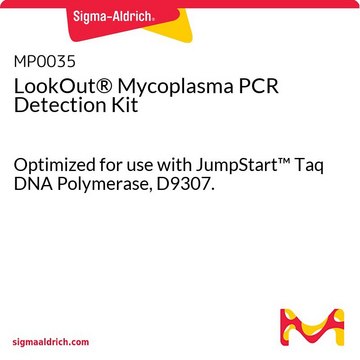MP0025
Venor™ GeM Mycoplasma Detection Kit, PCR-based
Synonym(s):
PCR mycoplasma detection kit
About This Item
Recommended Products
usage
kit sufficient for 25 tests
Quality Level
packaging
pkg of 1 kit
storage condition
dry at room temperature
technique(s)
PCR: suitable
application(s)
detection
microbiology
storage temp.
2-8°C
General description
Application
Components
Storage and Stability
Legal Information
Kit Components Only
- Positive Control
- Negative Control
- PCR 10X Reaction Buffer 500 mL/vial
- Primer/Nucleotide Mix 1 mL/vial
Storage Class Code
10 - Combustible liquids
WGK
WGK 3
Regulatory Listings
Regulatory Listings are mainly provided for chemical products. Only limited information can be provided here for non-chemical products. No entry means none of the components are listed. It is the user’s obligation to ensure the safe and legal use of the product.
PDSCL
Please refer to KIT Component information
PRTR
Please refer to KIT Component information
FSL
Please refer to KIT Component information
ISHL Indicated Name
Please refer to KIT Component information
ISHL Notified Names
Please refer to KIT Component information
Cartagena Act
Please refer to KIT Component information
JAN Code
キットコンポーネントの情報を参照してください
Certificates of Analysis (COA)
Search for Certificates of Analysis (COA) by entering the products Lot/Batch Number. Lot and Batch Numbers can be found on a product’s label following the words ‘Lot’ or ‘Batch’.
Already Own This Product?
Find documentation for the products that you have recently purchased in the Document Library.
Customers Also Viewed
Articles
Know when to use antibiotics to prevent contamination in cell culture and find related products at Sigma-Aldrich.com
Detect mycoplasma contamination in cell cultures three ways: culture test, DNA stain test, or mycoplasma PCR test. Mycoplasma elimination kits rid cultures of contamination.
Protocols
Mycoplasma contamination of cell cultures is a serious issue impacting cell model validity. PCR testing for mycoplasma is an inexpensive, sensitive, and specific method for detecting contamination.
Our team of scientists has experience in all areas of research including Life Science, Material Science, Chemical Synthesis, Chromatography, Analytical and many others.
Contact Technical Service










